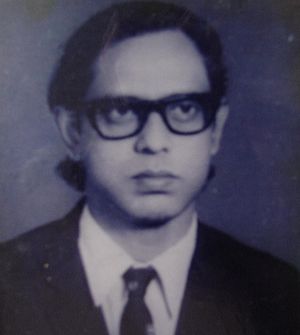Abdus Suttar Khan facts for kids
Quick facts for kids
Abdus Suttar Khan
|
|
|---|---|
 |
|
| Born | 1941 |
| Died | 31 January 2008 (aged 67) |
| Education | PhD (Chemistry) |
| Alma mater | Comilla Victoria College University of Dhaka University of Oxford |
| Scientific career | |
| Institutions | Florida State University, NASA, Alstom, United Technologies |
Abdus Suttar Khan (born around 1941, died January 31, 2008) was a brilliant scientist from Bangladesh. He spent forty years researching for big companies like NASA and United Technologies. Dr. Khan invented over forty special metal mixtures called alloys. These alloys were used in amazing things like space shuttles, jet engines, and even fast train engines!
Contents
Early Life and Learning
Abdus Suttar Khan was born in a village called Khagatua. This village is in the Brahmanbaria District of what was then British India. Today, it is part of Bangladesh.
He went to Ratanpur High School. Later, he studied at Comilla Victoria College. He was a very bright student!
Dr. Khan then went to the University of Dhaka. He earned his Bachelor of Science degree in 1962. He was the top student in his class. In 1963, he got his master's degree in chemistry. After that, he started teaching chemistry at the same university.
In 1964, he received a special scholarship. This allowed him to study at the famous University of Oxford in England. He earned his PhD degree in chemistry there in 1968. After his PhD, Dr. Khan returned to Dhaka University. He worked as a professor until 1973. That year, he moved to the United States. He wanted to do more research on special metals called alloys.
Amazing Inventions
During his career, Dr. Khan invented more than forty different alloys. Alloys are special mixtures of metals. These alloys were designed to work in very hot places. For example, they were used in the blades of gas turbines and jet engines.
These special metals were also covered with protective layers. These layers stopped them from rusting or wearing out. They also helped the metals handle very high temperatures.
Used in Space and Air
Dr. Khan's inventions were used in many important machines. They helped build space shuttles and advanced jet engines. The US Air Force also used these alloys in their fighter jets.
His alloys made engines lighter. Lighter engines meant aircraft could fly much faster!
Faster Trains and Power
Dr. Khan also worked in Switzerland. There, he developed alloys that made train engines faster. These special metals also improved industrial gas turbines. These turbines are used to generate electricity.
One of his most important inventions was a strong nickel-based alloy. This alloy was used in F-15 and F-16 fighter jet engines. It helped these jets use less fuel. This invention was even called a "21st Century material" in a science magazine!
Special Products Developed
Dr. Khan's work led to many useful products. Here are some examples:
- Nano-catalysts: These tiny particles help fuel burn better in advanced jet engines. This allows for very fast flight.
- Abrasion-resistant materials: These materials resist wear and tear. They made US Air Force fighter engines more fuel-efficient.
- Corrosion-resistant coatings: These special layers protect jet engine parts from rust and damage. They were used in Pratt & Whitney jet engines.
- Wear-resistant coatings: These coatings were used in powerful industrial gas turbine engines. They made parts last longer.
- Oxidation-resistant coatings: These coatings protected parts in other industrial gas turbine engines. They helped prevent damage from heat and air.
Awards and Recognitions
Dr. Khan received many important awards for his amazing work. These awards came from NASA, the US Air Force, United Technology, and Alstom.
He was also a Chartered Scientist in Great Britain. This means he was recognized as a professional scientist. He was also a Fellow of the Royal Society of Chemistry. This is a very high honor for a chemist!
Here are some of his key awards:
- 1986 United Technologies Special Award: He received this for creating a strong nickel-based alloy. This alloy, called Alloy Y, made F-15 and F-16 fighter engines more fuel-efficient. This alloy was even featured in a magazine!
- United Technologies Research Center Award of Excellence (1994): This award was for developing a unique way to make catalysts. These catalysts helped high-speed aircraft and missiles.
- NASA-Air Force Recognition (1992): The technology he developed for hydrocarbon fuel was called an "enabling technology." This means it made new things possible.
- Pratt & Whitney's Special Award (1993): He received this for helping create new ways to protect surfaces in jet engines.
Later Life
After retiring, Dr. Khan continued his research. He became an honorary professor at Florida State University. He worked on creating a special center there. This center would focus on tiny materials called nanomaterials. He hoped to use these materials in science and medicine.
Helping the Community
Besides his scientific work, Dr. Khan also helped his community in the United States. He started the Bangladeshi Association of Florida. He also organized many events for the Asian community.
In 1991, there was a big flood in Bangladesh. Dr. Khan raised $61,000 to help the victims. He gave this money to the Red Cross. He also helped set up a partnership between Dhaka University and Lamar University in Texas. This partnership helped train teachers and students from Dhaka University.

